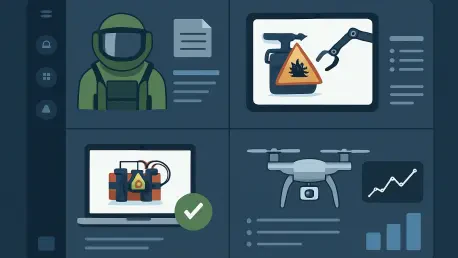Imagine a bustling city in Germany coming to a sudden halt as construction workers unearth an unexploded aerial bomb from World War II, a relic of a bygone era that still poses a deadly threat, forcing evacuations and road closures. With hundreds of thousands of such bombs buried beneath the soil, each discovery triggers heightened tension and significant challenges in maintaining safety. The challenge lies not only in neutralizing these hazards but in doing so with minimal disruption to daily life and maximum safety for all involved. This guide aims to illuminate how cutting-edge software is revolutionizing explosive ordnance disposal (EOD) by providing precise tools to predict blast effects and optimize safety protocols. Readers will learn the step-by-step process of leveraging technology to transform controlled detonations into safer, more efficient operations.
The purpose of this guide is to equip EOD professionals, safety officials, and community stakeholders with actionable insights into using simulation software for managing unexploded ordnance risks, thereby highlighting a path toward reducing the societal impact of these operations. By delving into specific tools and methodologies, it aims to safeguard lives and infrastructure effectively. The importance of this topic cannot be overstated, as traditional methods often lead to overly broad evacuation zones and unaddressed underground dangers, amplifying both cost and concern. Through a detailed exploration of software applications, this resource offers a window into a safer approach grounded in precision and innovation.
This guide also seeks to bridge the gap between historical challenges and modern solutions by exploring how the lingering presence of wartime bombs underscores a unique intersection of past conflicts and present-day urban development, where technology serves as a critical ally. By understanding how digital tools enhance decision-making in high-stakes scenarios, readers can appreciate the broader implications for public safety and emergency response. The following sections break down the process into clear, manageable steps, ensuring that even complex concepts are accessible and applicable to real-world situations.
Revolutionizing Safety in Unexploded Ordnance Disposal
The specter of unexploded aerial bombs from World War II continues to haunt regions like Germany, where an estimated hundreds of thousands remain hidden beneath urban and rural landscapes. Each discovery during construction or redevelopment projects sparks a race against time to protect communities from potential catastrophe. These incidents often necessitate evacuating entire city districts, shutting down transportation networks, and halting daily routines, creating a ripple effect of disruption. The stakes are immense, as a single misstep in handling such ordnance could result in devastating loss of life and property.
Enter the transformative power of software, a game-changer in the field of Explosive Ordnance Disposal (EOD). Advanced simulation tools are now enabling teams to predict blast effects with unprecedented accuracy, allowing for more targeted safety measures that reduce unnecessary evacuations. This technological leap addresses not only the immediate dangers of detonation but also the broader impact on infrastructure and public confidence. By integrating detailed 3D models of urban environments, these solutions offer a clearer picture of potential risks, paving the way for smarter, safer operations.
The key takeaway lies in the potential of digital innovation to rewrite the rules of ordnance disposal, transforming how professionals approach this critical field. Beyond mere prediction, software empowers experts to optimize every aspect of a mission, from planning evacuation zones to assessing underground threats. As cities continue to grow and unearth more remnants of war, adopting such tools becomes not just an option but a necessity for minimizing harm. This section sets the stage for a deeper dive into the historical context and specific applications that make this revolution possible.
The Persistent Threat of WWII Aerial Bombs
Decades after the end of World War II, unexploded aerial bombs remain a pressing concern across Germany, embedded in the ground as silent hazards waiting to be triggered. Historical estimates suggest that a significant portion of the millions of bombs dropped during the conflict failed to detonate, leaving a dangerous legacy beneath modern cities. With urban expansion and infrastructure projects on the rise, these relics are frequently uncovered, each instance demanding an immediate and meticulous response to prevent disaster.
The scale of this issue is staggering, as routine construction often turns into a high-risk operation requiring specialized EOD teams. Traditional challenges in handling these bombs include the uncertainty of blast wave propagation and fragmentation patterns, leading to expansive safety perimeters that displace thousands. Moreover, the potential underground impact on critical structures like pipelines, subway systems, and building foundations has historically been overlooked, compounding the complexity of each mission. Such factors highlight the inefficiencies of older methods and the urgent need for a more informed approach.
Addressing this persistent threat requires acknowledging the limitations of past practices and embracing innovation to tackle the challenges ahead. The unpredictability of aged ordnance, combined with the density of modern urban environments, creates a unique set of risks that cannot be mitigated by guesswork alone. Technological advancements offer a lifeline, providing data-driven insights that can refine safety protocols and reduce the societal burden of these operations. This context underscores the critical role of software in transforming how these dangers are managed.
How Software Transforms Controlled Detonations
The advent of specialized software has ushered in a new era for Explosive Ordnance Disposal (EOD), offering tools that enhance safety during the controlled detonation of aerial bombs. Solutions like VC BlastProtect, developed through collaborative efforts by research institutes and government bodies, provide a robust framework for simulating blast scenarios with remarkable detail. This section guides readers through the specific steps of applying such technology, ensuring that each phase of the process contributes to a safer outcome for all involved.
By breaking down complex simulations into actionable steps, EOD teams can make informed decisions that balance risk with efficiency, ensuring safer and more effective operations in the field. The software’s ability to model both aboveground and underground effects addresses long-standing gaps in traditional methods, while also evaluating protective measures tailored to specific situations. Each step outlined below focuses on a distinct aspect of this technology, providing clarity on how it integrates into real-world operations and mitigates the inherent dangers of unexploded ordnance.
Understanding the full scope of these tools requires a look at their practical applications across varied environments. From densely populated urban centers to rural construction sites, the challenges of detonation vary widely, yet the software adapts to each context with precision. The following subsections detail the critical stages of using simulation technology, offering a comprehensive roadmap for enhancing safety during these high-stakes missions.
Step 1 – Simulating Aboveground Blast Effects
The first step in leveraging software for safer detonations involves simulating aboveground blast effects using platforms like VC BlastProtect. This tool creates a 3D model of the surrounding cityscape, incorporating data on buildings, roads, and other infrastructure to predict how blast waves will propagate. By calculating overpressure levels and mapping potential fragment trajectories, it provides a clear visualization of areas at risk during a controlled detonation.
This simulation capability marks a significant departure from the broad, often excessive safety zones of the past, allowing EOD teams to identify specific areas where overpressure or flying debris poses a threat. By doing so, they ensure that protective measures are both effective and proportionate to the risks involved. The precision of these predictions helps maintain public trust by demonstrating a commitment to minimizing disruption while prioritizing safety in every operation.
Defining Targeted Evacuation Zones
A critical outcome of aboveground simulations is the ability to define targeted evacuation zones with accuracy. By analyzing the predicted spread of blast effects and debris, the software enables teams to establish safety radii that protect vulnerable populations without unnecessarily displacing entire communities. This targeted approach reduces the logistical burden on local authorities and lessens the economic impact of temporary closures.
Such precision also fosters better communication with the public, as smaller, well-justified evacuation areas are more likely to be understood and accepted. EOD professionals can use these insights to coordinate with emergency services, ensuring that resources are allocated efficiently during an operation. This step underscores the value of data-driven planning in transforming a historically disruptive process into a more manageable one.
Step 2 – Modeling Underground Shock Waves
The second step focuses on extending simulation capabilities to model underground shock waves, often referred to as groundshock, through initiatives like the ShockAnalyst project. Unlike aboveground effects, the impact of detonations on subterranean structures such as pipelines and tunnels has historically been difficult to predict. Software advancements now allow for detailed analysis of how explosive energy travels through soil, identifying potential risks to critical infrastructure below the surface.
This development is crucial for urban areas where underground networks are integral to daily life, and by simulating the propagation of shock waves, EOD teams can assess whether a detonation might compromise nearby utilities or foundations. By doing so, they can enable preemptive measures to mitigate damage. This step addresses a previously neglected aspect of ordnance disposal, ensuring a more holistic approach to safety planning.
Tackling the Complexity of Soil Behavior
A significant challenge in modeling underground effects lies in understanding soil behavior under extreme conditions, which is critical for accurate predictions in various engineering and environmental applications. Soil is a complex, three-phase mixture of solid particles, water, and air, with properties that vary widely depending on composition and location. Advanced software incorporates data from dynamic laboratory tests to simulate these interactions, striving for accuracy in predicting how shock waves will dissipate or intensify through different ground types.
This focus on soil dynamics requires ongoing research to refine models, as factors like moisture content and density play a pivotal role in outcomes. By addressing these variables, the technology ensures that underground risk assessments are as reliable as their aboveground counterparts. Such efforts highlight the interdisciplinary nature of modern EOD, blending geotechnical science with digital innovation for comprehensive safety solutions.
Step 3 – Evaluating Damping Measures
The third step involves using software to evaluate the effectiveness of damping measures, which are physical barriers designed to reduce the impact of a detonation. Common techniques include covering a bomb with sand or water to limit fragment flight and absorb explosive energy. Simulations quantify how these methods alter blast wave propagation and debris spread, providing data to optimize their application in specific scenarios.
This analytical approach allows for a deeper understanding of how different configurations influence outcomes, moving beyond trial-and-error to evidence-based strategies. EOD teams can test multiple damping setups virtually before implementing them on-site, saving time and resources while enhancing protection. This step demonstrates the practical utility of simulation tools in refining traditional safety practices for better results.
Optimizing On-Site Safety Protocols
With simulation insights, EOD professionals can tailor damping configurations to the unique conditions of each operation, optimizing on-site safety protocols. For instance, software might reveal that a particular thickness of sand cover significantly reduces fragment range in a given soil type, guiding precise setup decisions. This customization ensures that protective measures are neither over- nor under-applied, striking a balance between caution and efficiency.
Such tailored protocols also enhance coordination among response teams, as clear data supports unified planning and execution. By integrating these findings into operational guidelines, the software helps standardize best practices across diverse scenarios. This focus on adaptability underscores the transformative potential of technology in managing unpredictable risks with confidence.
Step 4 – Validating Models with Real-World Tests
The final step in this process involves validating software models through real-world tests, such as a large-scale experiment conducted in Mecklenburg-Vorpommern. During this trial, multiple 500-pound bombs were detonated under varied conditions to compare simulation predictions with actual outcomes. Sensors and monitoring equipment captured data on blast effects, fragment distribution, and ground shock, providing a benchmark for model accuracy.
These tests are essential for building trust in digital tools, as they reveal both strengths and areas for improvement in simulations. While results often show that models err on the side of caution by overestimating damage, this conservative approach aligns with safety priorities. Validation exercises ensure that software remains a reliable partner in planning, grounding virtual predictions in tangible evidence.
Bridging Virtual Predictions and Reality
Bridging the gap between virtual predictions and reality, test outcomes confirm the practical value of simulation software in EOD operations. Though conservative estimates may lead to slightly broader safety measures than necessary, they provide a buffer that prioritizes human life above all else. This cautious stance is a deliberate design choice, reflecting the high stakes of ordnance disposal in populated areas.
Moreover, real-world validation offers insights for refining future iterations of the software, incorporating lessons learned into updated algorithms. By aligning digital forecasts with physical results, EOD teams can approach each mission with greater assurance, knowing their tools have been tested under rigorous conditions. This step completes the cycle of development, application, and improvement, solidifying technology’s role in safer detonations.
Key Takeaways from Software-Driven EOD Safety
The integration of simulation software into EOD operations yields several core benefits, summarized below for quick reference and practical application:
- Aboveground Precision: Tools like VC BlastProtect predict blast waves and fragment trajectories, enabling targeted evacuation zones that minimize community disruption.
- Underground Protection: Advanced models assess groundshock, safeguarding pipelines, tunnels, and foundations from the unseen effects of detonations.
- Damping Effectiveness: Simulations quantify the impact of safety measures like sand or water coverage, allowing for optimized hazard reduction strategies.
- Validation through Testing: Real-world tests confirm software reliability, supporting safer operations with data-backed risk assessments.
Broader Implications and Future Horizons in EOD Technology
The adoption of software-driven approaches in handling aerial bomb detonations extends far beyond immediate safety applications, influencing wider trends in public safety and emergency response. By providing a blueprint for data-informed decision-making, these tools can integrate with other disaster management technologies, such as seismic monitoring or flood prediction systems. This synergy has the potential to create a more cohesive framework for addressing multifaceted urban risks, particularly in regions with historical ordnance challenges.
In the realm of urban planning, simulation software offers valuable insights for designing infrastructure in areas prone to bomb discoveries, allowing planners to create safer environments. Planners can use risk assessments to prioritize protective measures or allocate resources for rapid response, embedding resilience into city development. The impact on community preparedness is equally significant, as smaller, more precise evacuation zones reduce public fatigue and foster trust in safety protocols, ensuring cooperation during critical operations.
Looking ahead, challenges remain in perfecting soil behavior models and accounting for diverse variables like complex infrastructure layouts, which can significantly impact outcomes. Future advancements may include real-time simulation updates during operations, allowing teams to adjust plans on the fly based on evolving conditions. While limitations persist, such as the need for extensive data inputs and computational power, the trajectory of EOD technology points toward increasingly sophisticated tools that balance innovation with practicality, promising safer environments for generations to come.
Embracing Technology for Safer Communities
Reflecting on the journey through this guide, it has become evident that software has reshaped the landscape of explosive ordnance disposal, turning unpredictable risks into manageable challenges. Each step, from simulating blast effects to validating models with real-world tests, has contributed to a framework that prioritizes safety while reducing societal impact. The transformation achieved through tools like VC BlastProtect has proven that technology can bridge historical threats with modern solutions, protecting lives and infrastructure alike.
Moving forward, stakeholders were encouraged to advocate for broader adoption of these digital tools, fostering partnerships between governments, research institutions, and local communities to enhance the effectiveness of such initiatives. Exploring funding opportunities to support ongoing development and training for EOD teams emerged as a vital next step. Additionally, staying informed about advancements in simulation technology offered a way to anticipate and prepare for evolving challenges in ordnance disposal.
As a final consideration, integrating these innovations into national safety strategies has the potential to set a global standard for handling unexploded ordnance. By championing collaboration and investment in such technologies, a foundation is laid not only for addressing past dangers but also for building resilient systems for future emergencies. This commitment to progress ensures that the shadows of war diminish in the light of safer, smarter practices.









